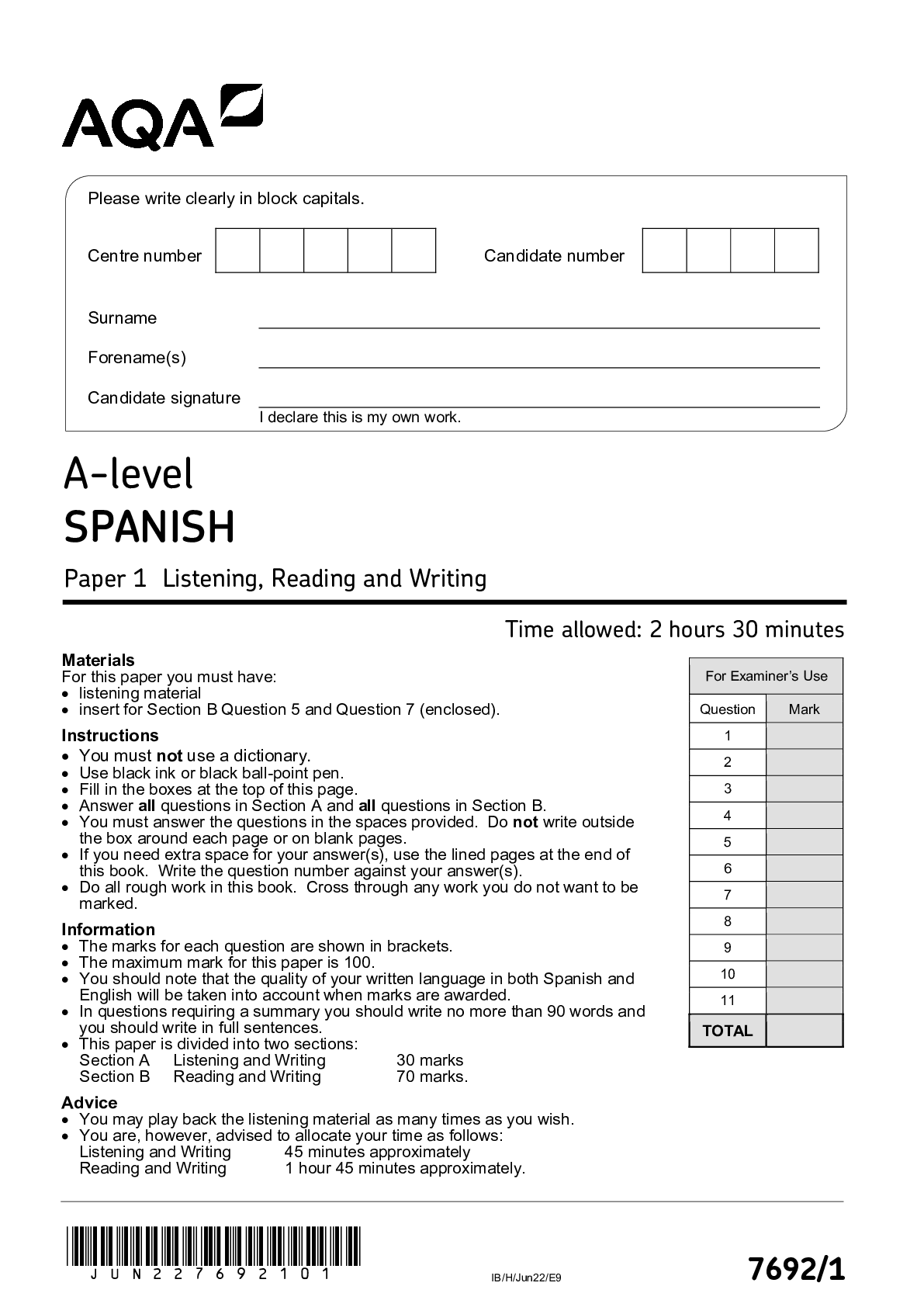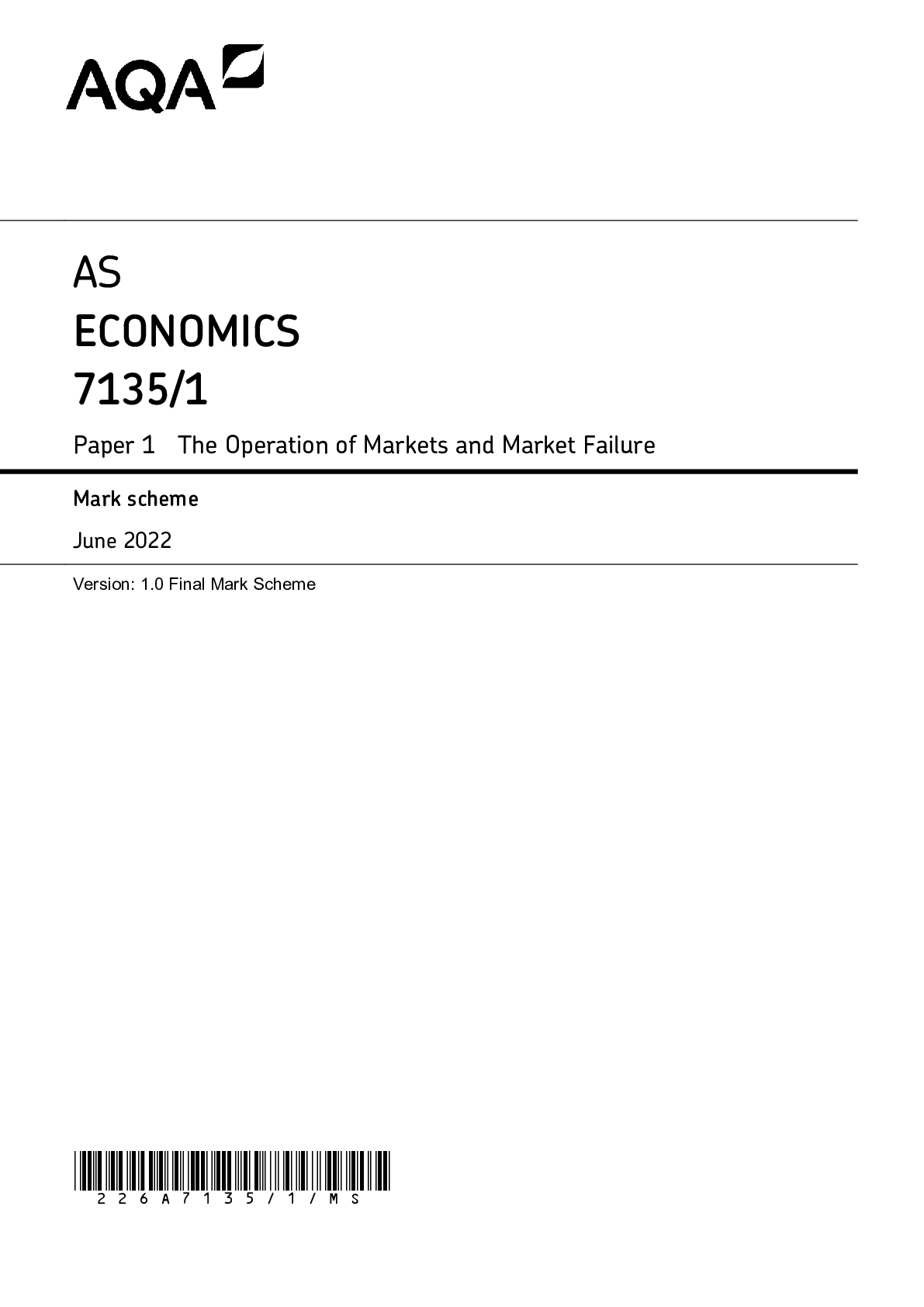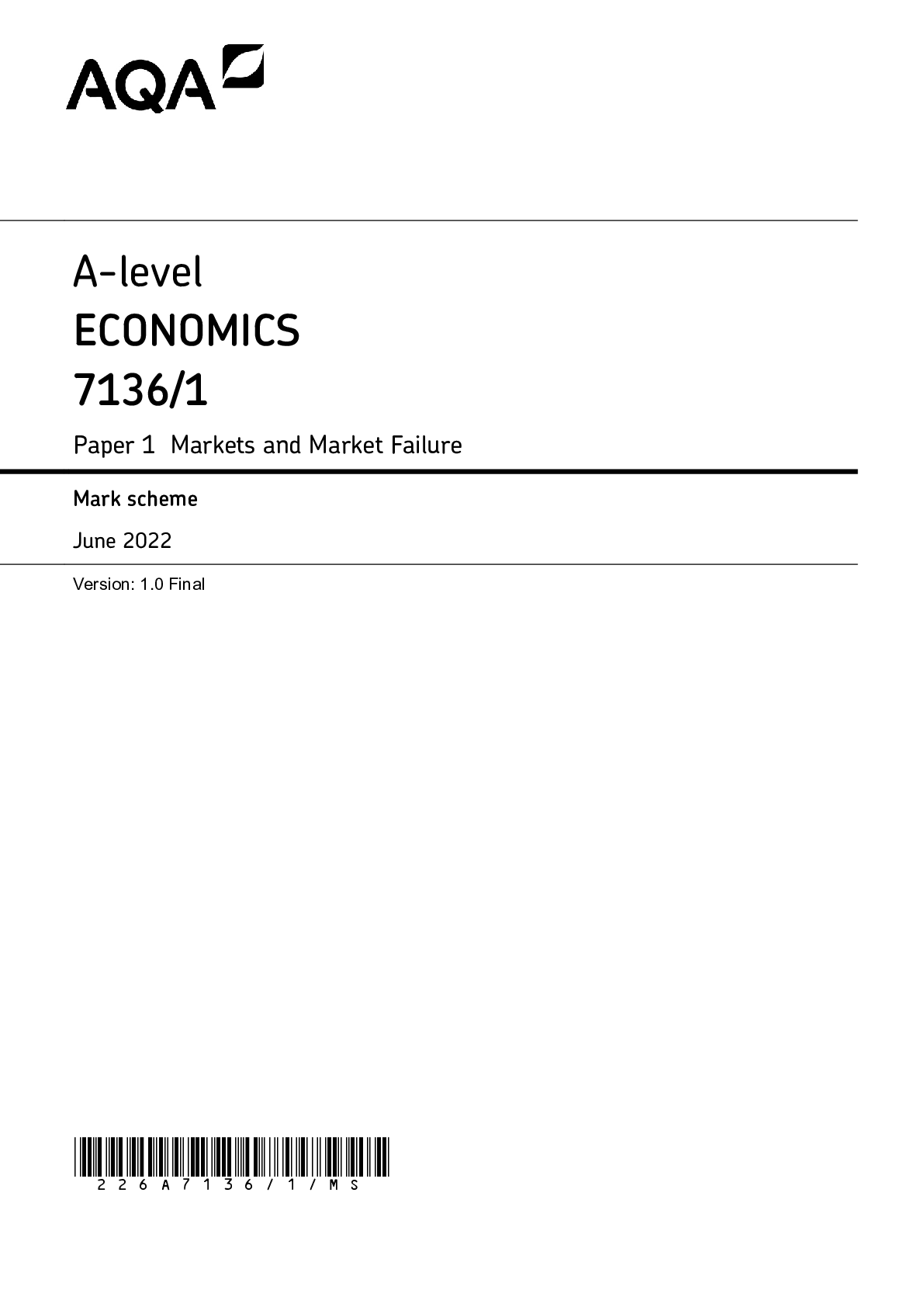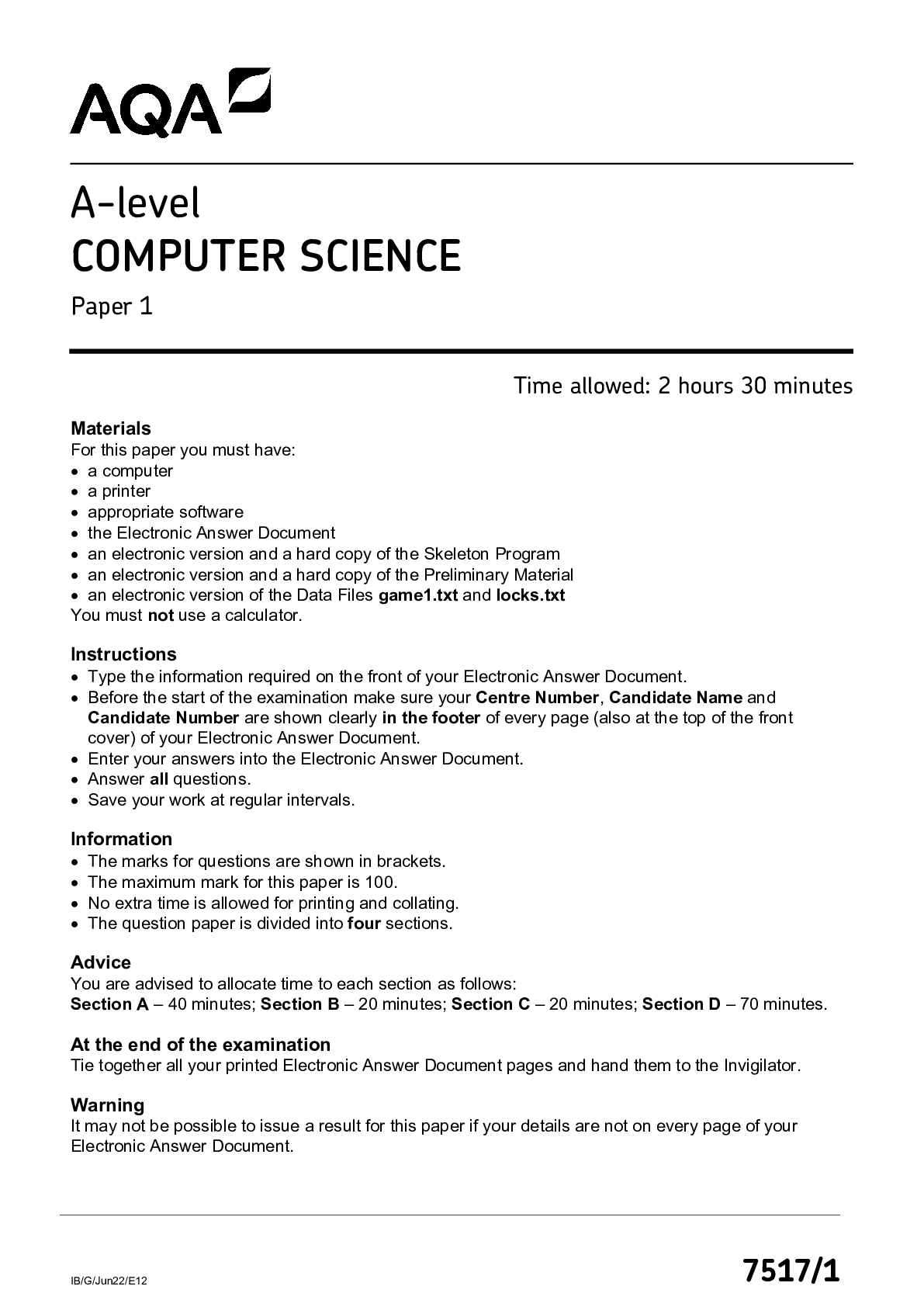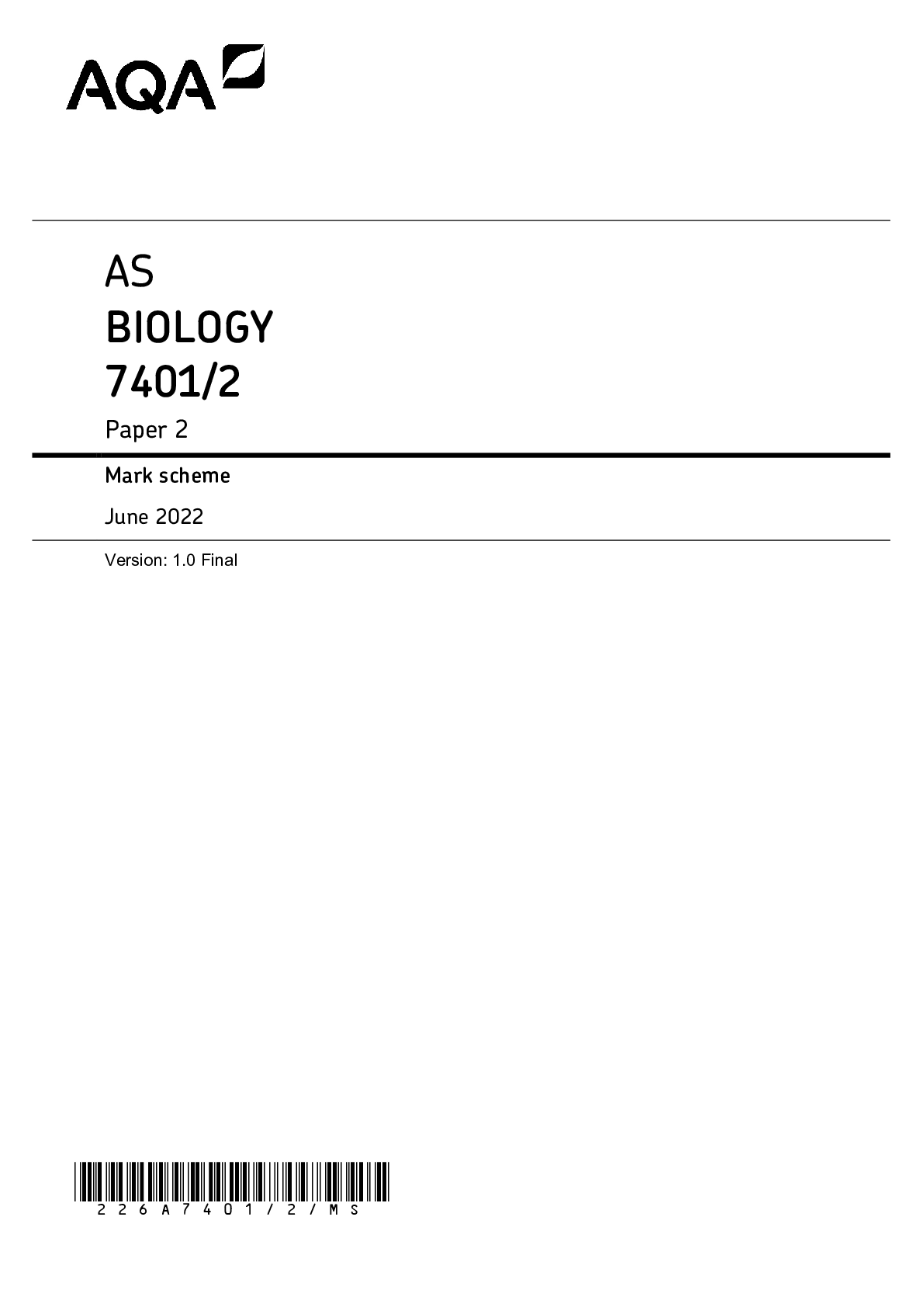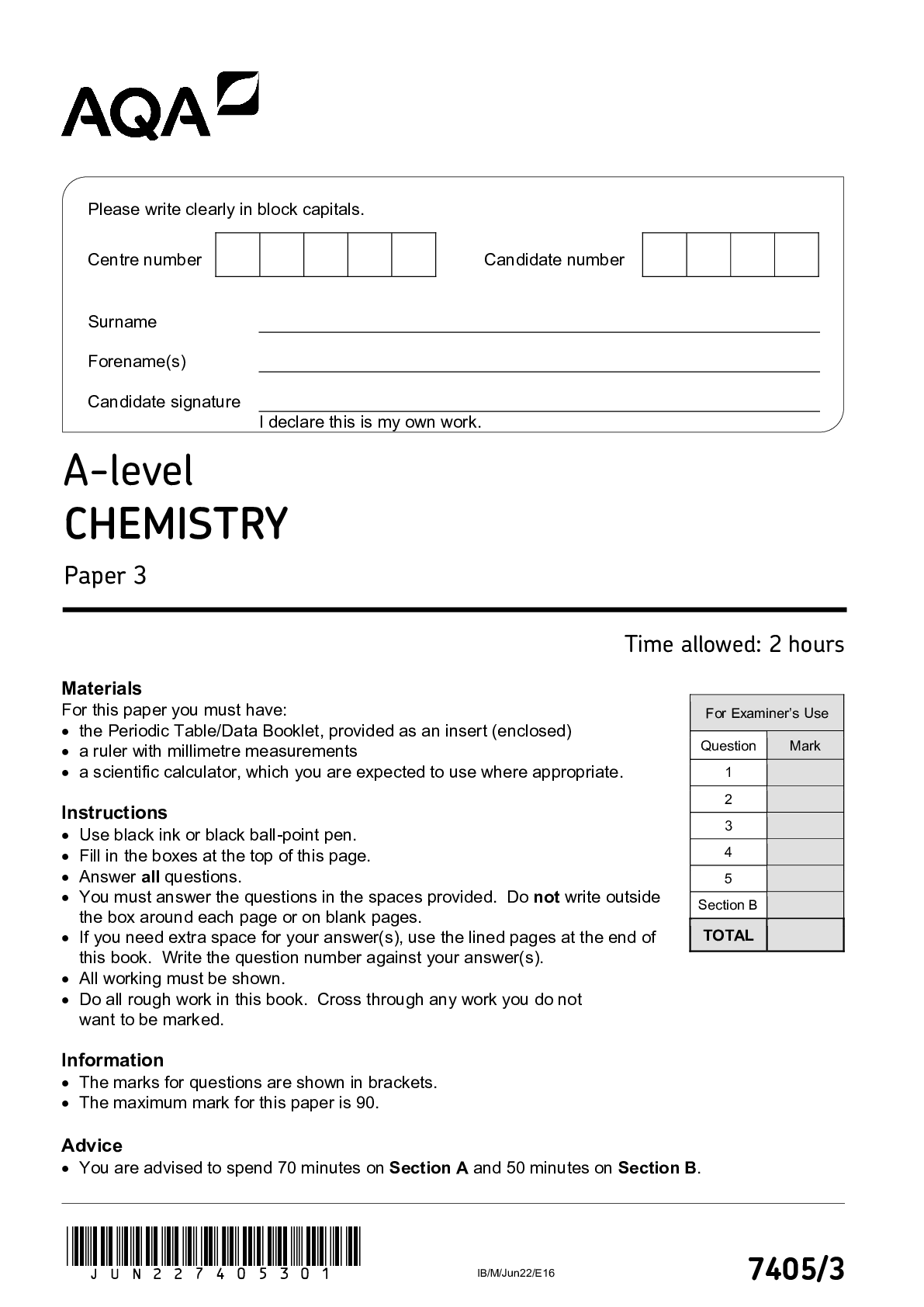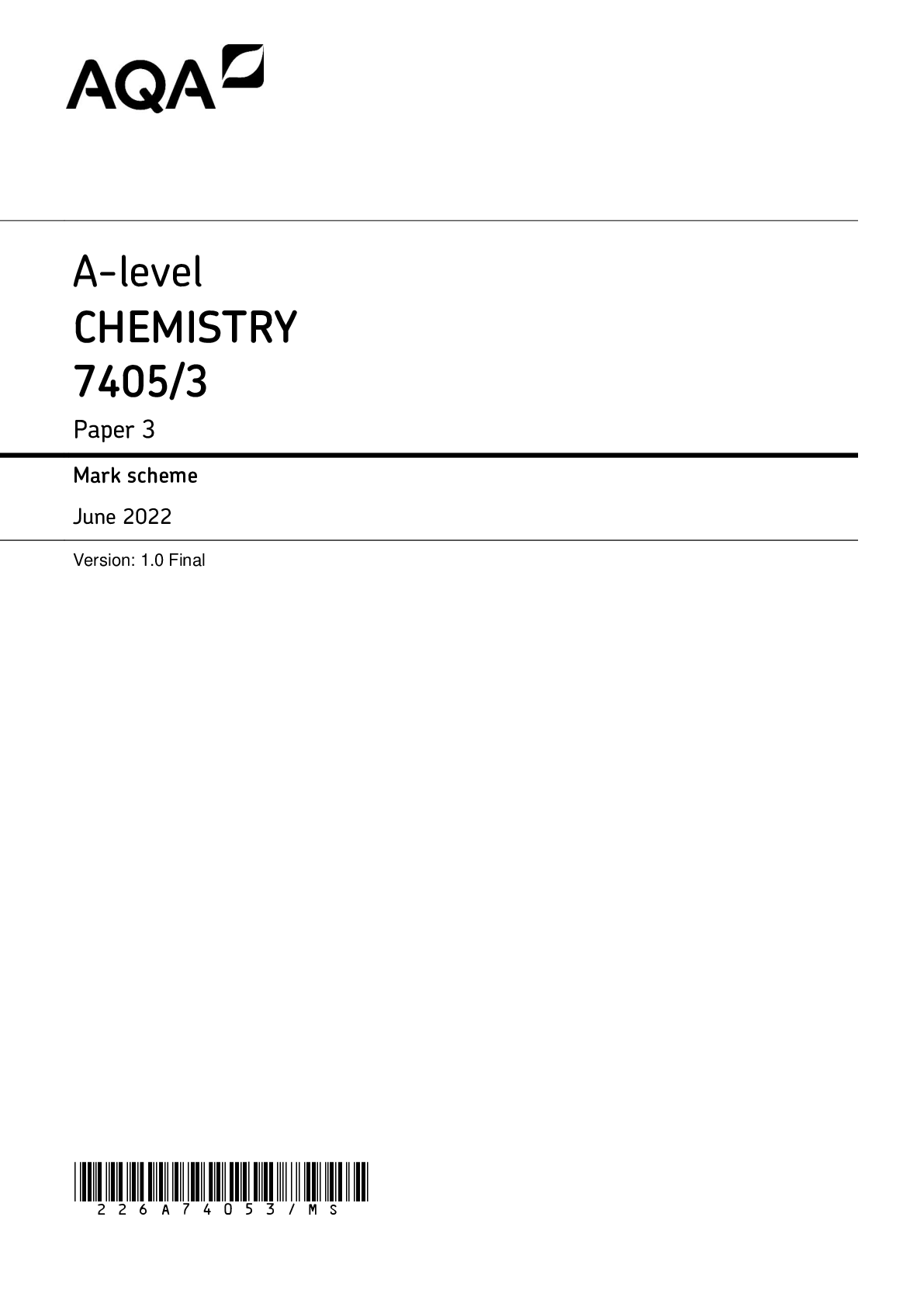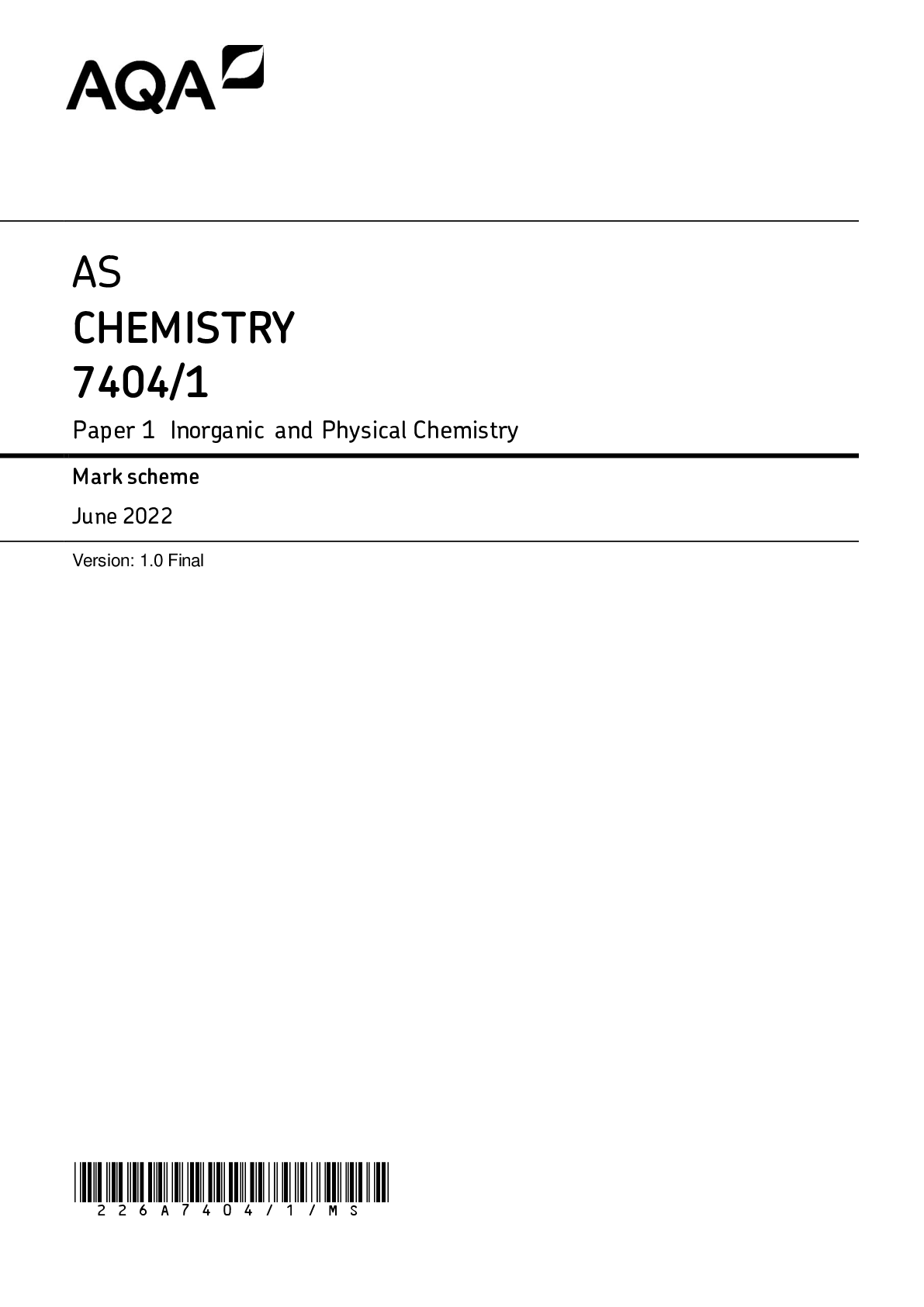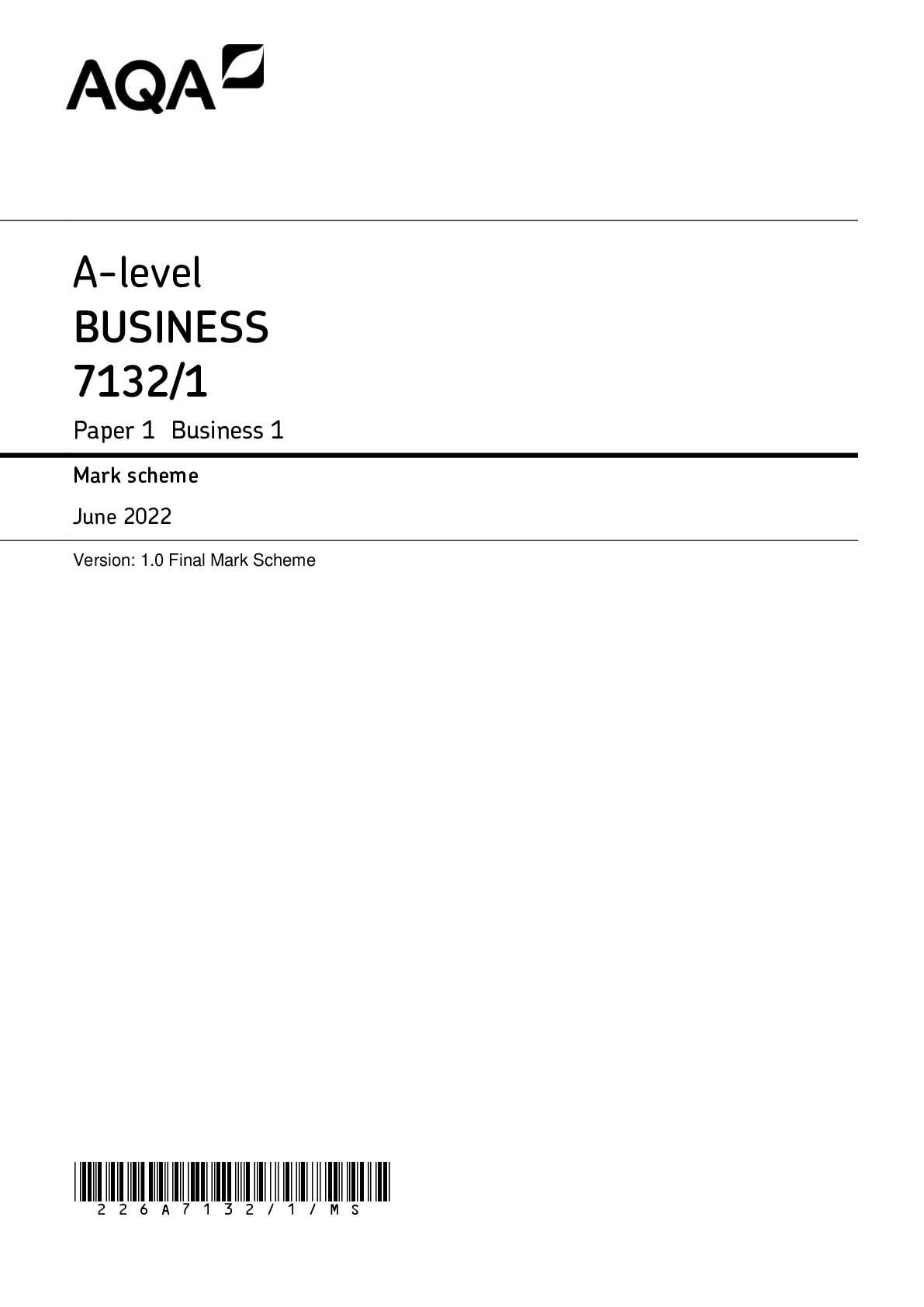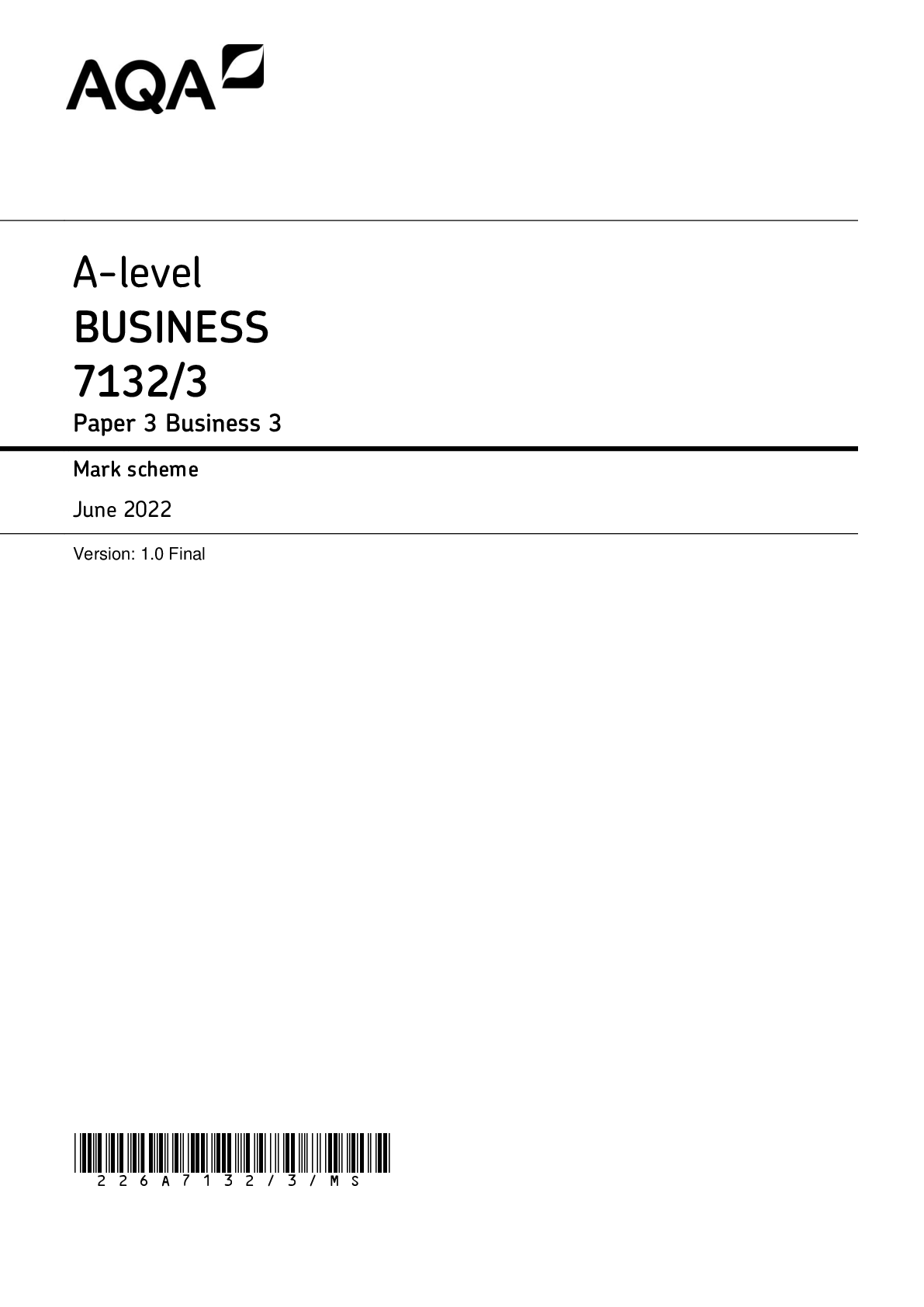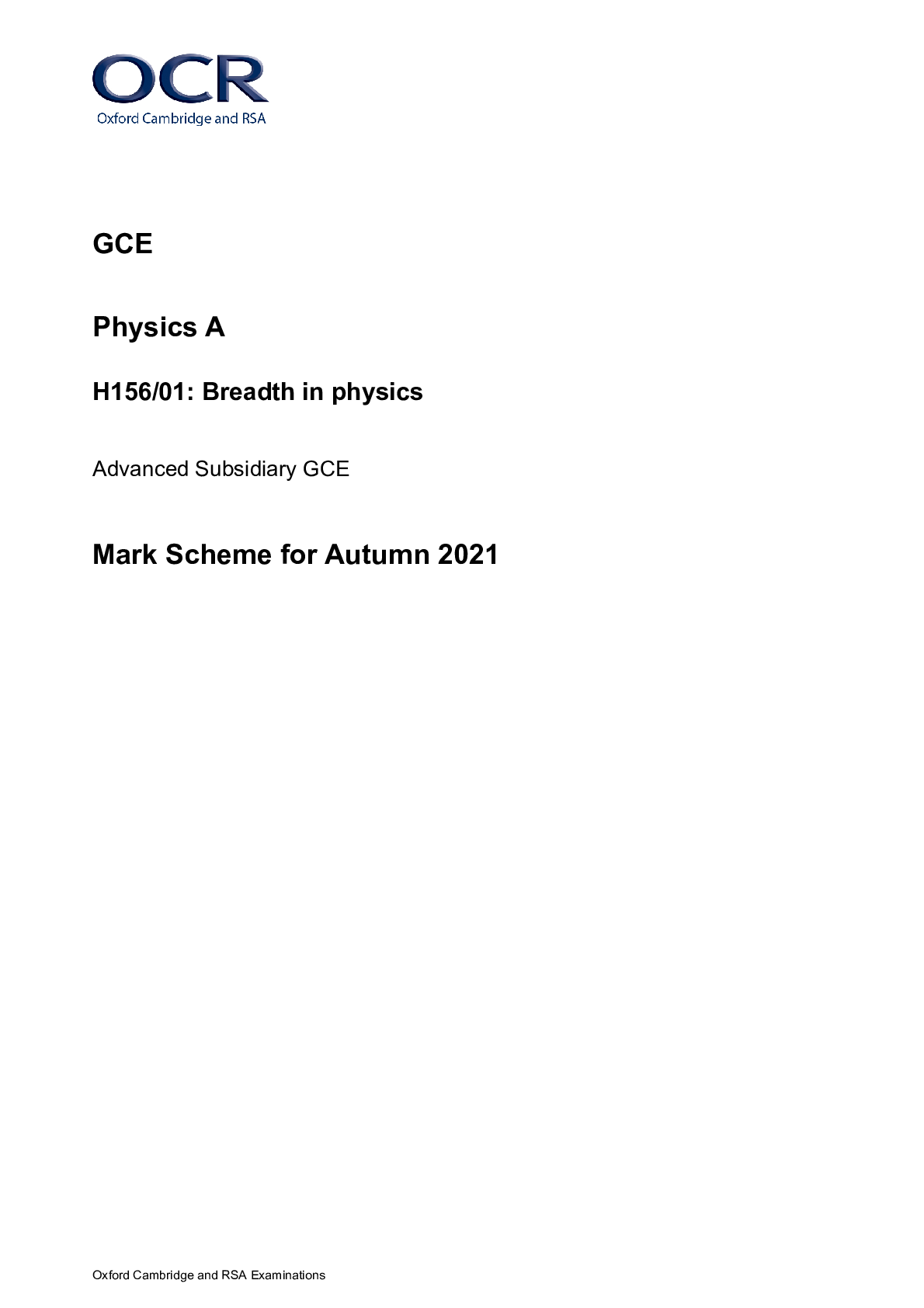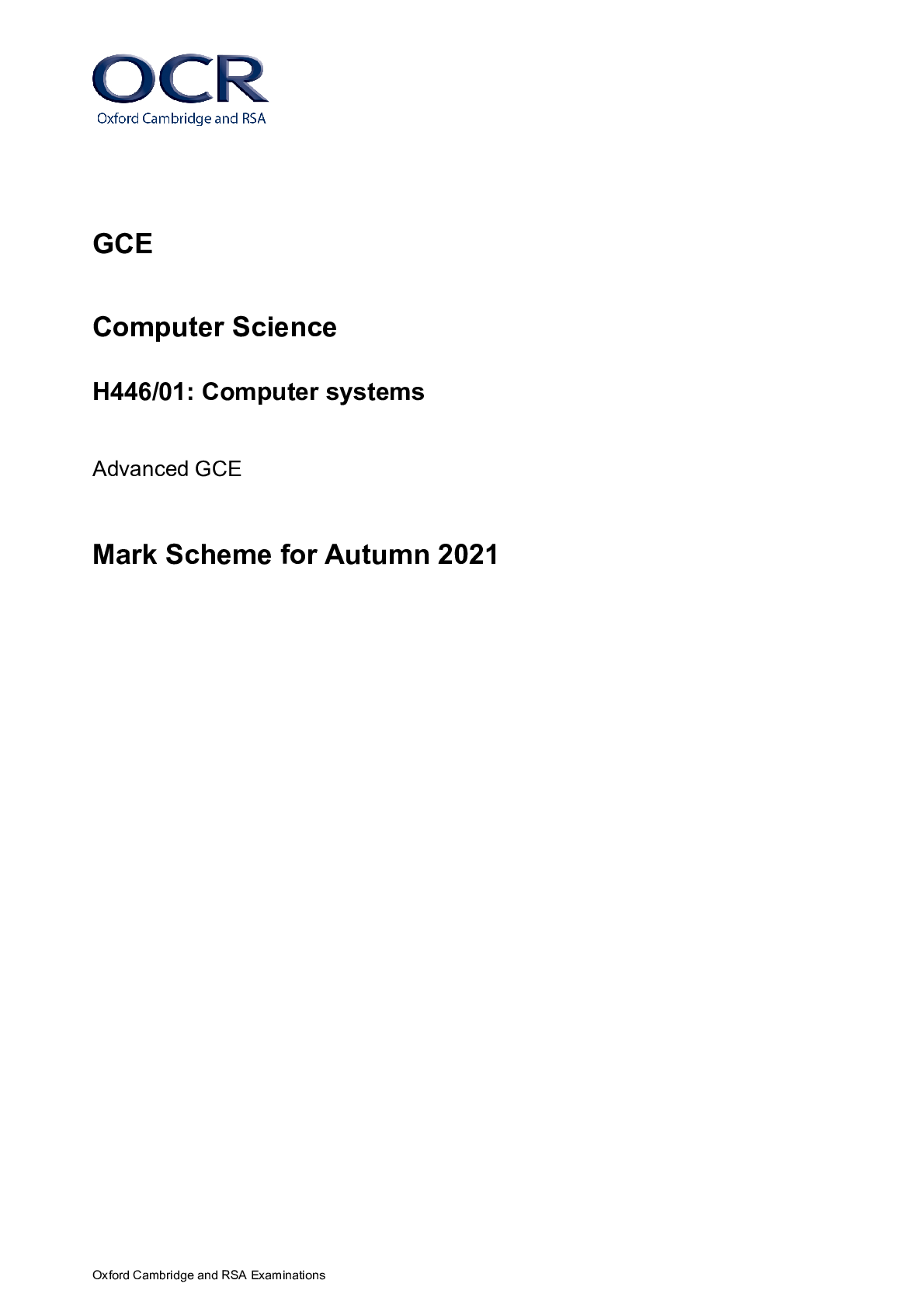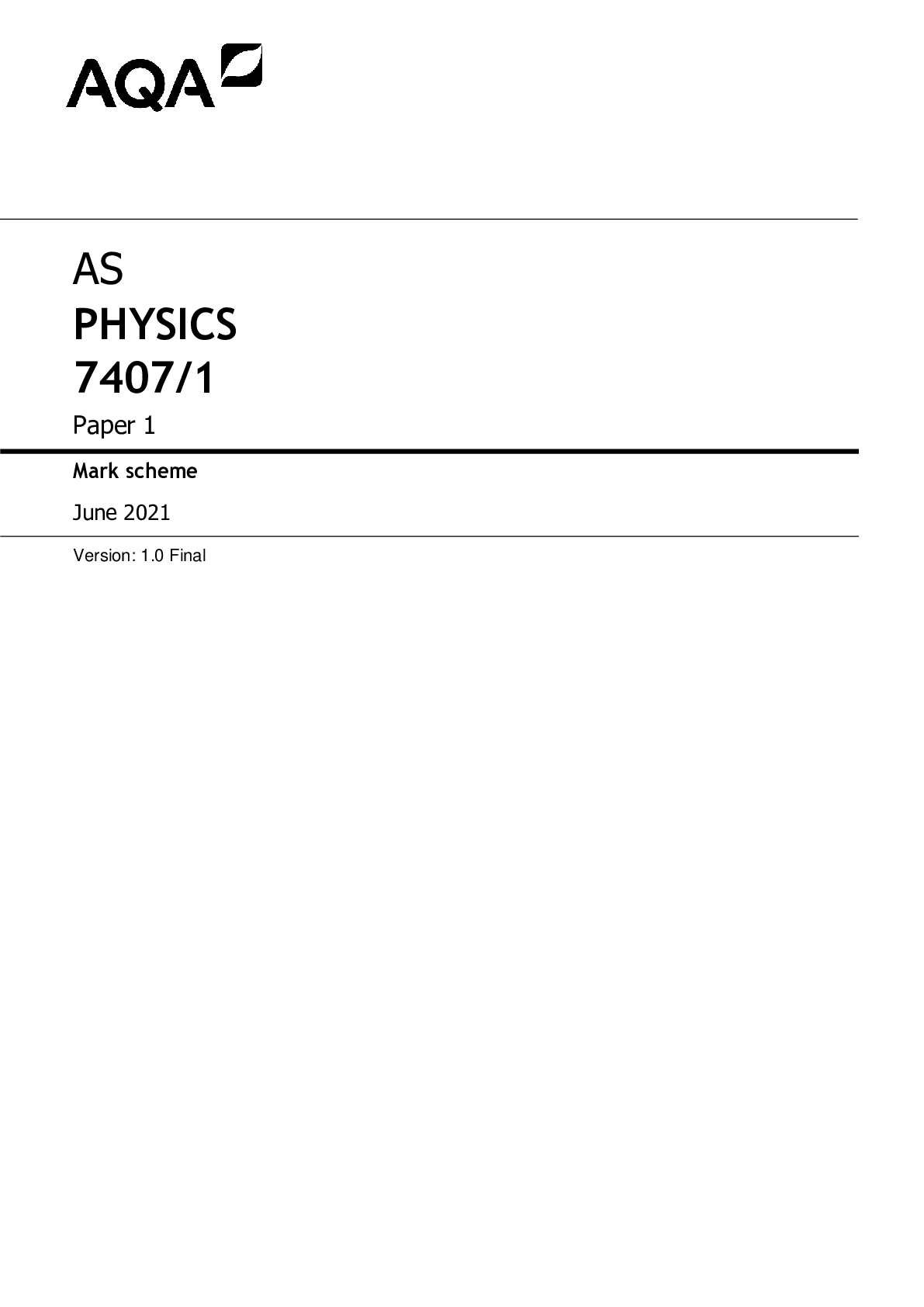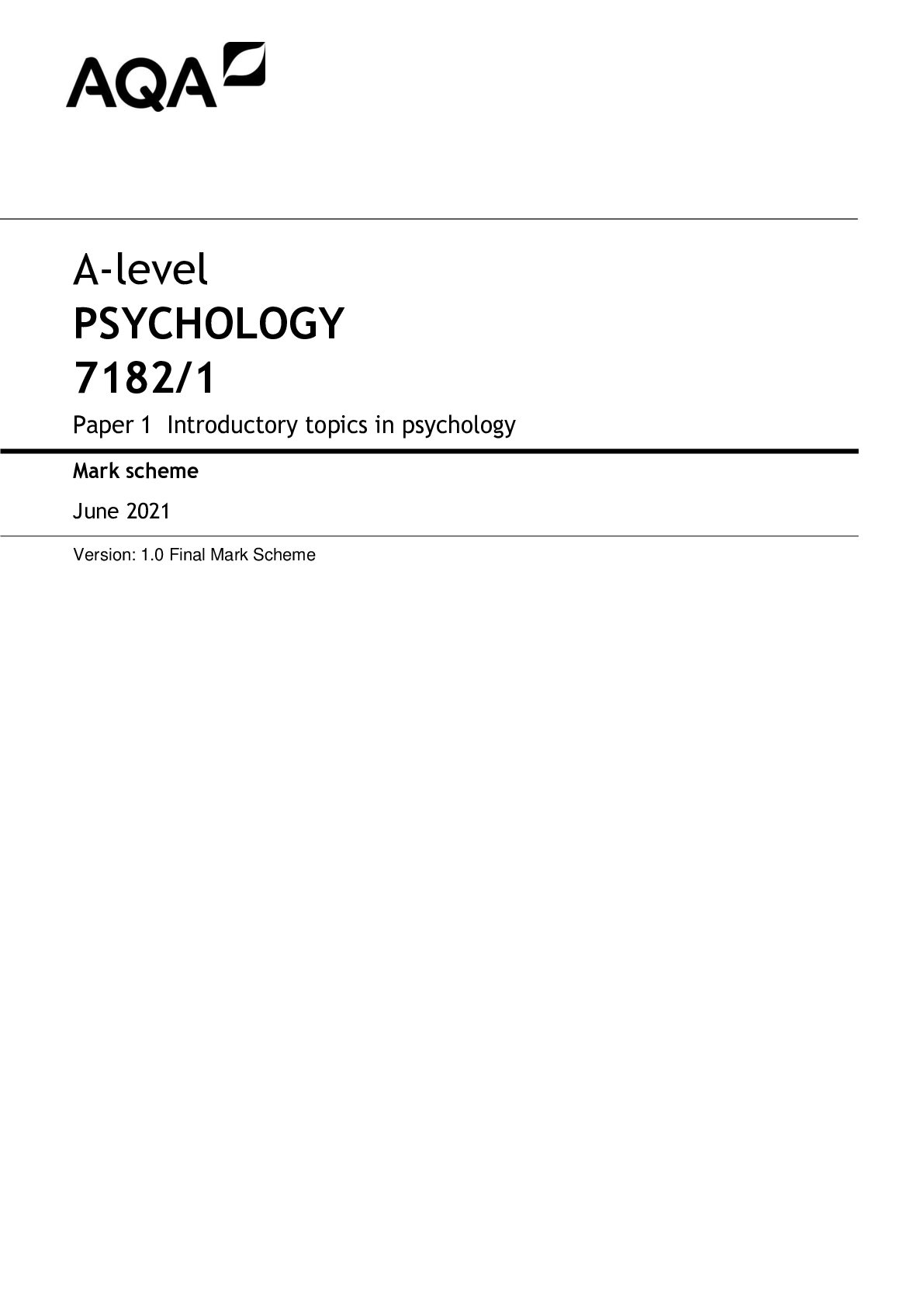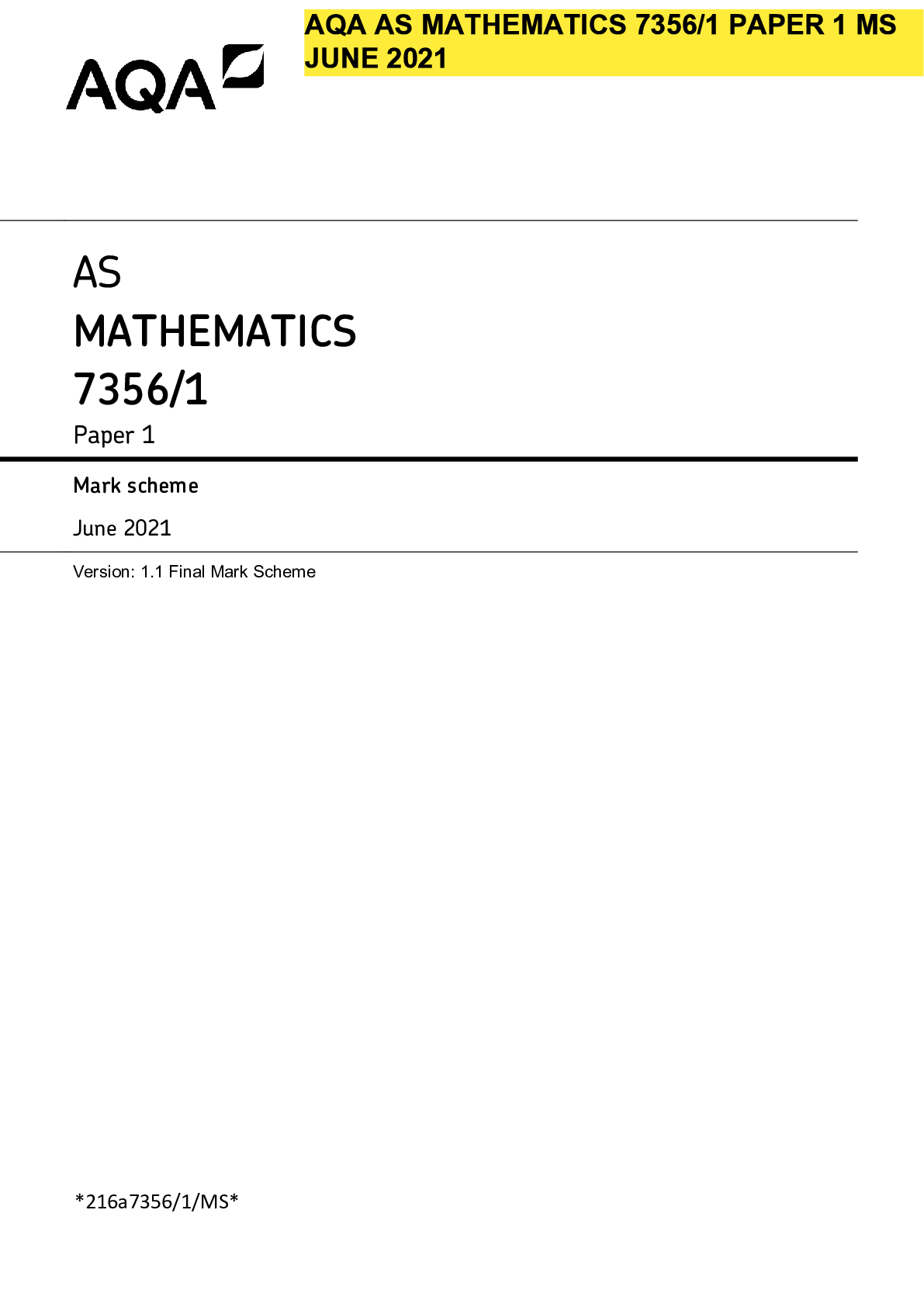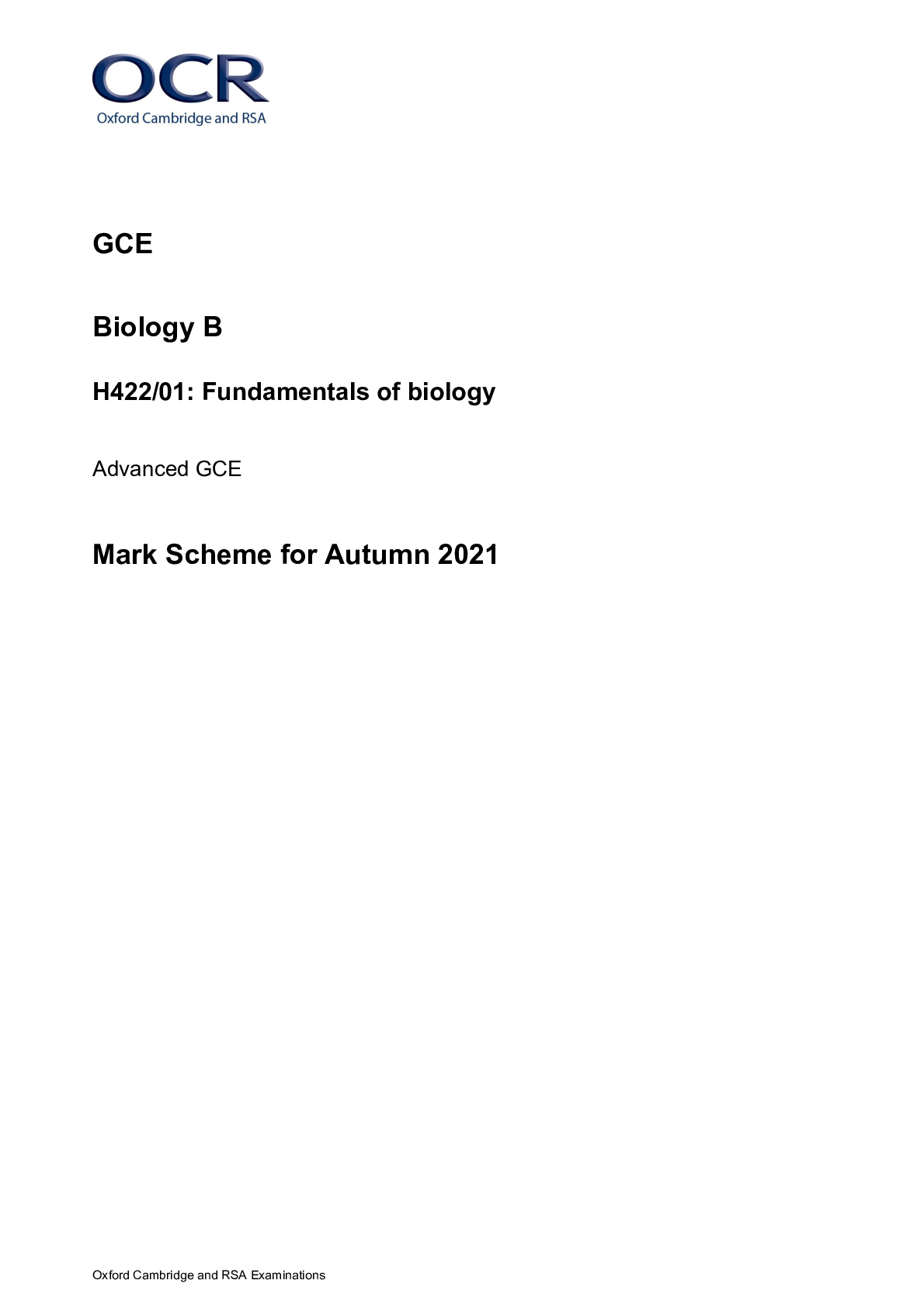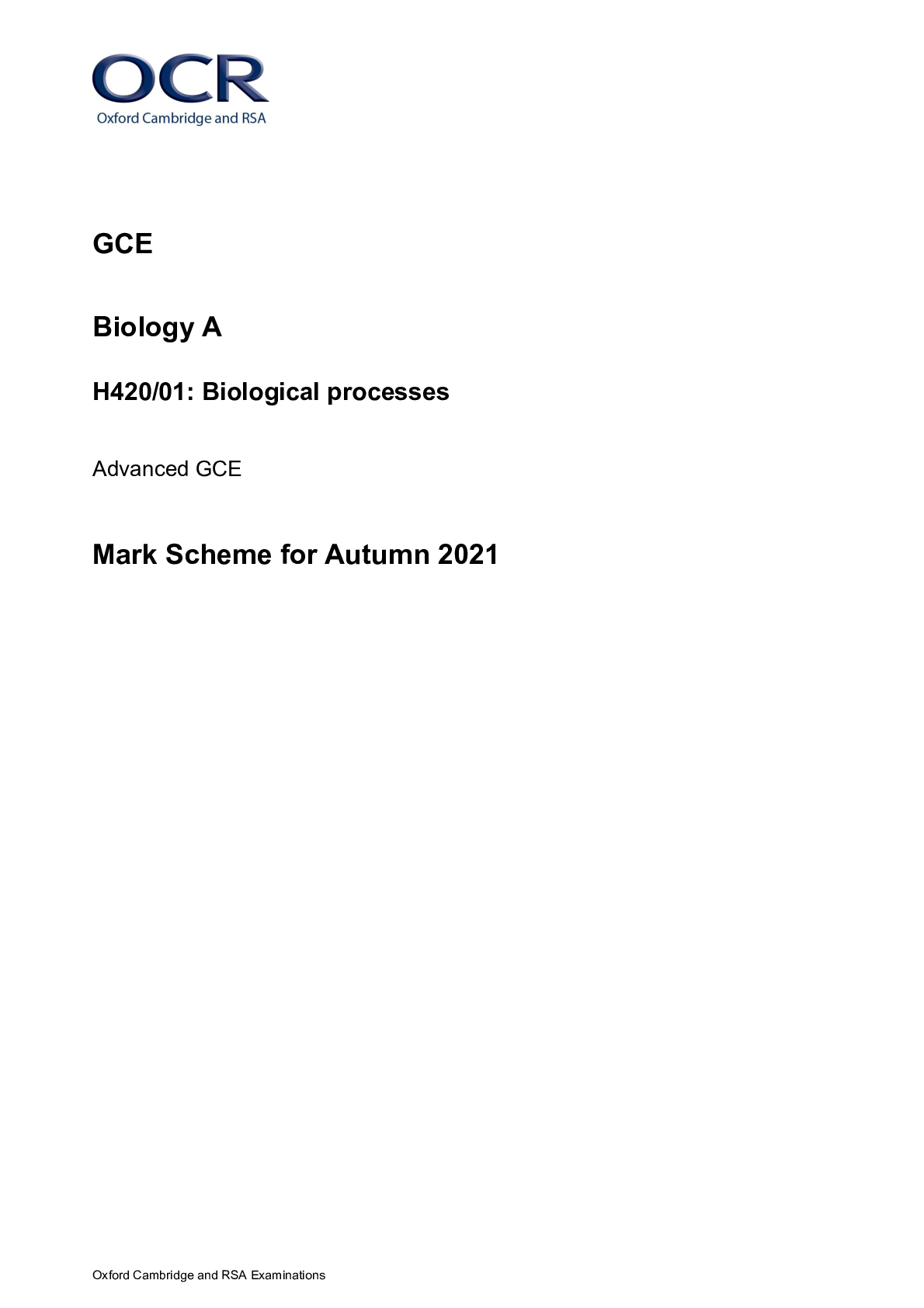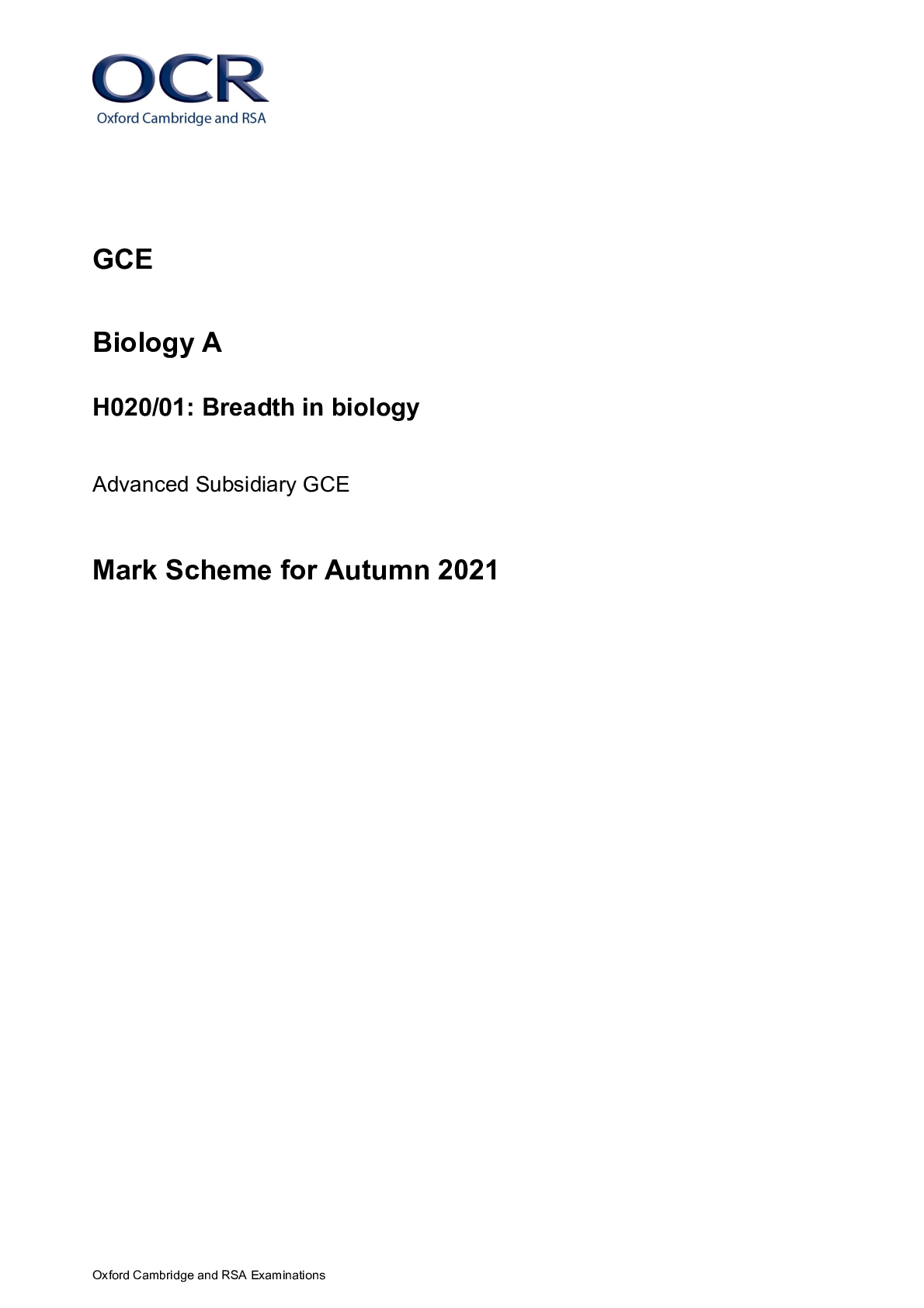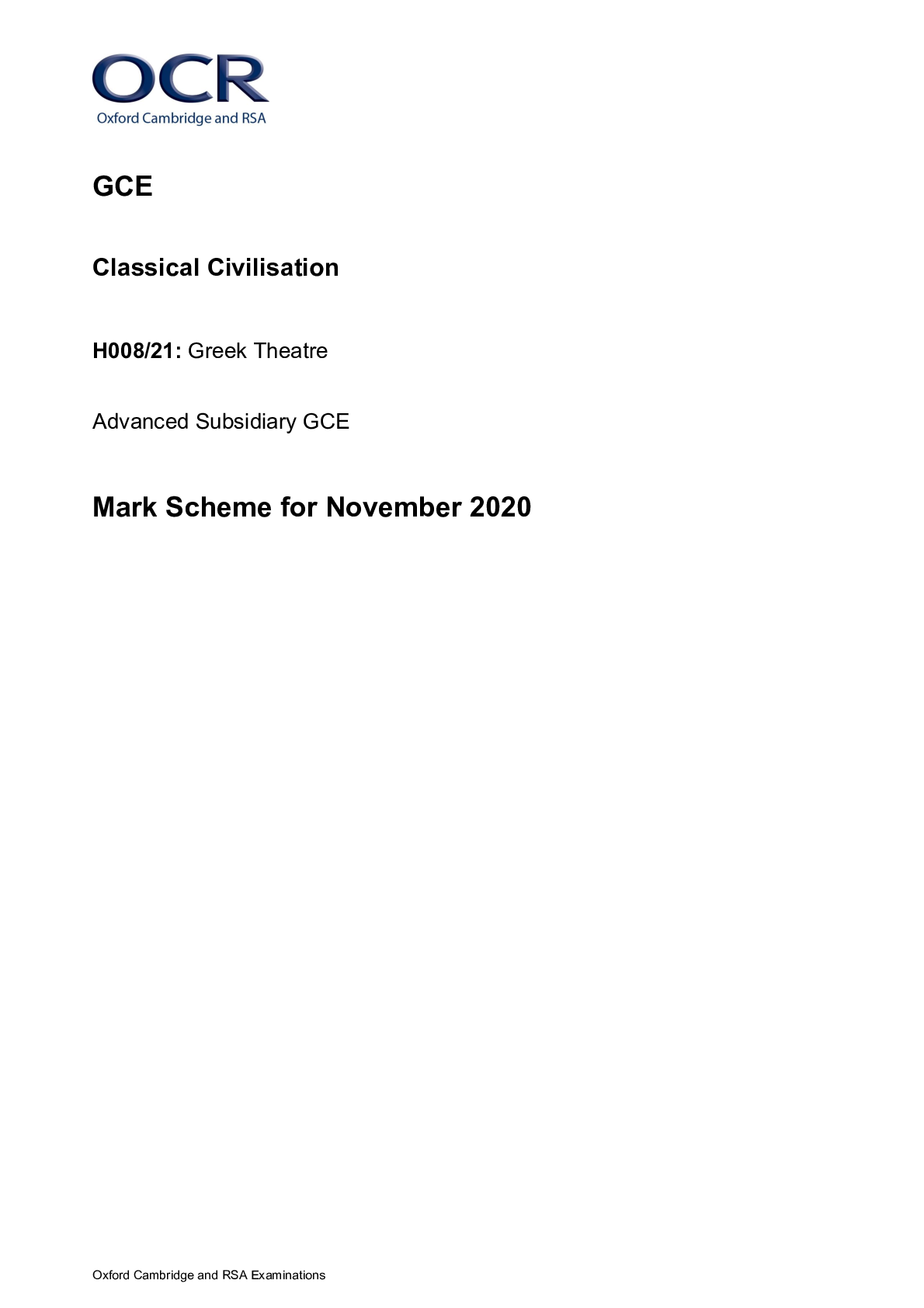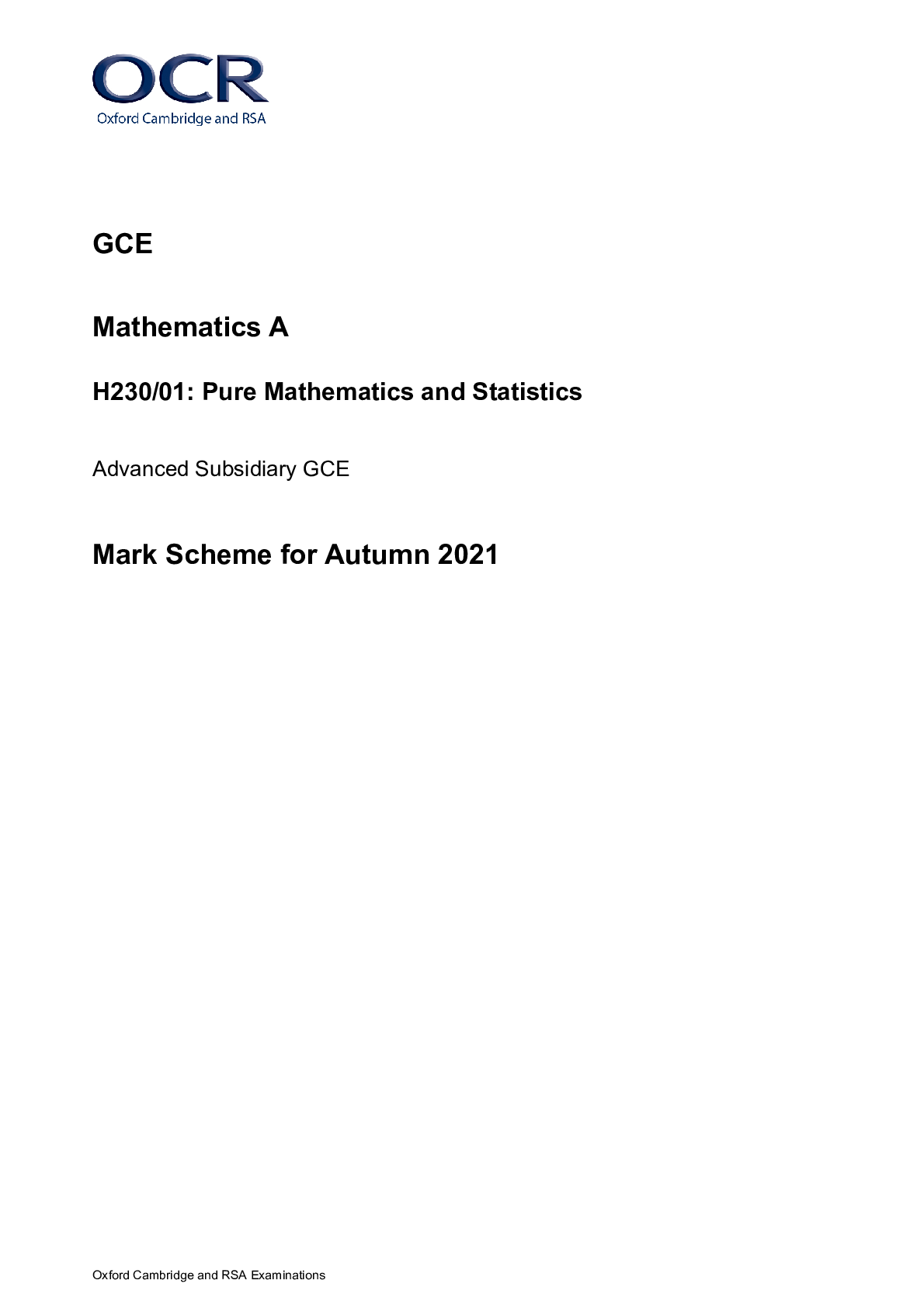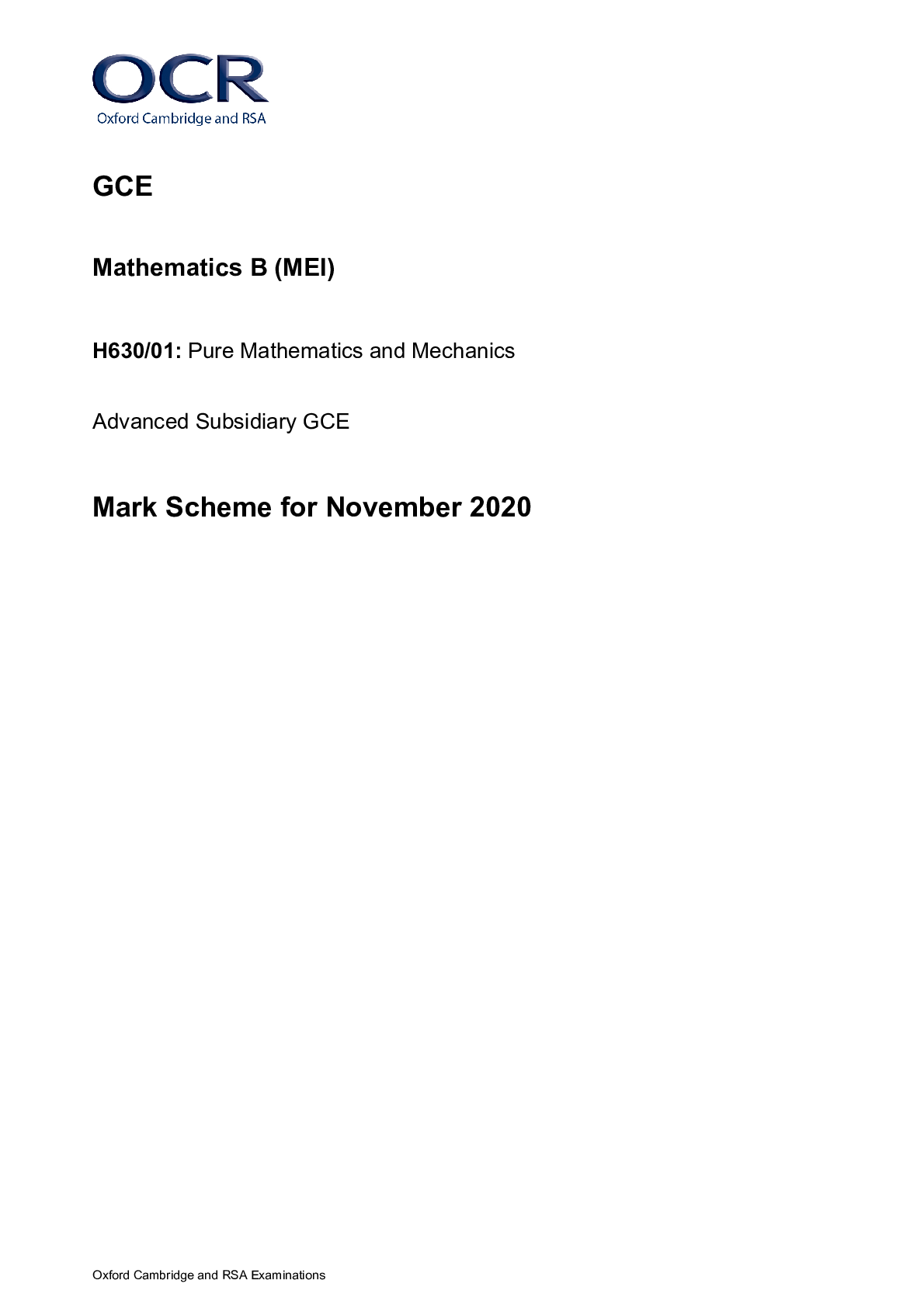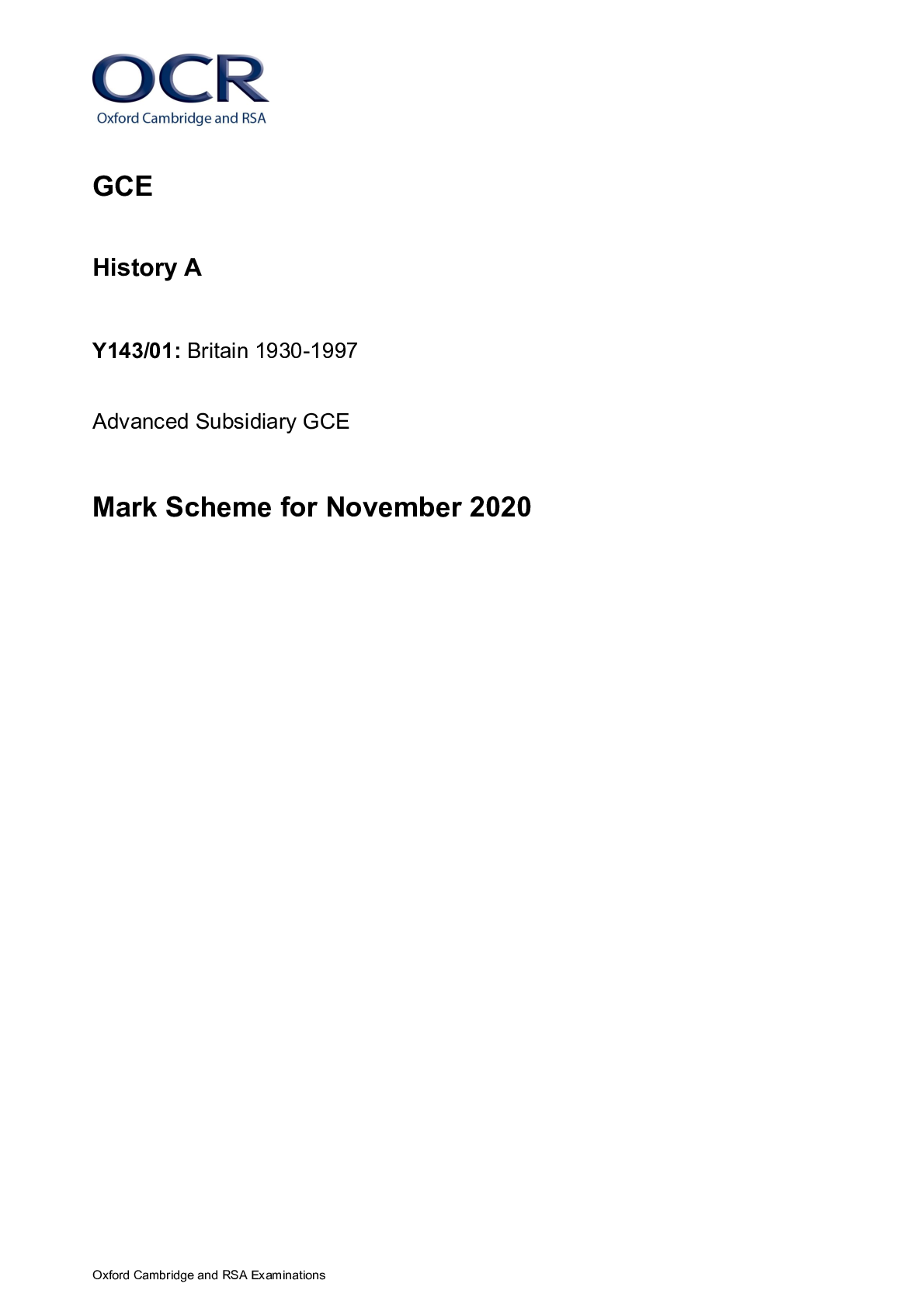Computer Science > AS Level Mark Scheme > A-level COMPUTER SCIENCE 7517/1 Paper 1 Mark scheme June 2022 Version: 1.0 Final *226A7517/1/MS* MA (All)
A-level COMPUTER SCIENCE 7517/1 Paper 1 Mark scheme June 2022 Version: 1.0 Final *226A7517/1/MS* MARK SCHEME – A-LEVEL COMPUTER SCIENCE – 7517/1 – JUNE 2022 2
Document Content and Description Below
A-level COMPUTER SCIENCE 7517/1 Paper 1 Mark scheme June 2022 Version: 1.0 Final *226A7517/1/MS* MARK SCHEME – A-LEVEL COMPUTER SCIENCE – 7517/1 – JUNE 2022 2 Mark schemes are prepare... d by the Lead Assessment Writer and considered, together with the relevant questions, by a panel of subject teachers. This mark scheme includes any amendments made at the standardisation events which all associates participate in and is the scheme which was used by them in this examination. The standardisation process ensures that the mark scheme covers the students’ responses to questions and that every associate understands and applies it in the same correct way. As preparation for standardisation each associate analyses a number of students’ scripts. Alternative answers not already covered by the mark scheme are discussed and legislated for. If, after the standardisation process, associates encounter unusual answers which have not been raised they are required to refer these to the Lead Examiner. It must be stressed that a mark scheme is a working document, in many cases further developed and expanded on the basis of students’ reactions to a particular paper. Assumptions about future mark schemes on the basis of one year’s document should be avoided; whilst the guiding principles of assessment remain constant, details will change, depending on the content of a particular examination paper. Further copies of this mark scheme are available from aqa.org.uk Copyright information AQA retains the copyright on all its publications. However, registered schools/colleges for AQA are permitted to copy material from this booklet for their own internal use, with the following important exception: AQA cannot give permission to schools/colleges to photocopy any material that is acknowledged to a third party even for internal use within the centre. Copyright © 2022 AQA and its licensors. All rights reserved. MARK SCHEME – A-LEVEL COMPUTER SCIENCE – 7517/1 – JUNE 2022 3 Level of response marking instructions Level of response mark schemes are broken down into levels, each of which has a descriptor. The descriptor for the level shows the average performance for the level. There are marks in each level. Before you apply the mark scheme to a student’s answer read through the answer and annotate it (as instructed) to show the qualities that are being looked for. You can then apply the mark scheme. Step 1 Determine a level Start at the lowest level of the mark scheme and use it as a ladder to see whether the answer meets the descriptor for that level. The descriptor for the level indicates the different qualities that might be seen in the student’s answer for that level. If it meets the lowest level then go to the next one and decide if it meets this level, and so on, until you have a match between the level descriptor and the answer. With practice and familiarity you will find that for better answers you will be able to quickly skip through the lower levels of the mark scheme. When assigning a level you should look at the overall quality of the answer and not look to pick holes in small and specific parts of the answer where the student has not performed quite as well as the rest. If the answer covers different aspects of different levels of the mark scheme you should use a best fit approach for defining the level and then use the variability of the response to help decide the mark within the level, ie if the response is predominantly level 3 with a small amount of level 4 material it would be placed in level 3 but be awarded a mark near the top of the level because of the level 4 content. Step 2 Determine a mark Once you have assigned a level you need to decide on the mark. The descriptors on how to allocate marks can help with this. The exemplar materials used during standardisation will help. There will be an answer in the standardising materials which will correspond with each level of the mark scheme. This answer will have been awarded a mark by the Lead Examiner. You can compare the student’s answer with the example to determine if it is the same standard, better or worse than the example. You can then use this to allocate a mark for the answer based on the Lead Examiner’s mark on the example. You may well need to read back through the answer as you apply the mark scheme to clarify points and assure yourself that the level and the mark are appropriate. Indicative content in the mark scheme is provided as a guide for examiners. It is not intended to be exhaustive and you must credit other valid points. Students do not have to cover all of the points mentioned in the Indicative content to reach the highest level of the mark scheme. An answer which contains nothing of relevance to the question must be awarded no marks. MARK SCHEME – A-LEVEL COMPUTER SCIENCE – 7517/1 – JUNE 2022 4 A-level Computer Science Paper 1 (7517/1) – applicable to all programming languages A, B, C, D and E June 2022 The following annotation is used in the mark scheme: ; – means a single mark // – means an alternative response / – means an alternative word or sub-phrase A. – means an acceptable creditworthy answer R. – means reject answer as not creditworthy NE. – means not enough I. – means ignore DPT. – means ‘Don't penalise twice’. In some questions a specific error made by a candidate, if repeated, could result in the loss of more than one mark. The DPT label indicates that this mistake should only result in a candidate losing one mark, on the first occasion that the error is made. Provided that the answer remains understandable, subsequent marks should be awarded as if the error was not being repeated. MARK SCHEME – A-LEVEL COMPUTER SCIENCE – 7517/1 – JUNE 2022 5 Examiners are required to assign each of the candidate’s responses to the most appropriate level according to its overall quality, and then allocate a single mark within the level. When deciding upon a mark in a level examiners should bear in mind the relative weightings of the assessment objectives eg In question 05.1, the marks available for the AO3 elements are as follows: AO3 (design) 4 marks AO3 (programming) 8 marks Where a candidate’s answer only reflects one element of the AO, the maximum mark they can receive will be restricted accordingly. MARK SCHEME – A-LEVEL COMPUTER SCIENCE – 7517/1 – JUNE 2022 6 Question Marks 01 All marks AO1 (knowledge) Algorithm Time Complexity Binary tree search O(log n) Bubble sort O(n2 ) Linear search O(n) Merge sort O(n log n) A. O(n x log n) NE. O(log n) A. log2 instead of log I. missing brackets I. missing O Mark as follows: 1 mark: 1 st row correct 1 mark: 2 nd row correct 1 mark: 3 rd row correct 3 MARK SCHEME – A-LEVEL COMPUTER SCIENCE – 7517/1 – JUNE 2022 7 Question Marks 02 1 All marks for AO1 (understanding) 1. Check the queue is (not already) empty; 2. Compare the value of the front pointer with the maximum size of the array; 3. If equal then front pointer becomes one; A. index of the first position in the array instead of one 4. Otherwise, add one to the front pointer; Alternative answer 1 1. Check the queue is (not already) empty; 2. Compare the value of the front pointer with the maximum size of the array minus one; 3. If equal then front pointer becomes zero; A. index of the first position in the array instead of zero 4. Otherwise, add one to the front pointer; Alternative answer 2 1. Check the queue is (not already) empty; 2. Add one to the front pointer; 3. Compare the value of the front pointer with the maximum size of the array; 4. If equal then front pointer becomes zero; A. index of the first position in the array instead of zero Alternative answer 3 1. Check the queue is (not already) empty; 2. Add one to the front pointer; 3. Compare the value of the front pointer with the maximum size of the array plus one; 4. If equal then front pointer becomes one; A. index of the first position in the array instead of one Alternative answer 4 1. Check the queue is (not already) empty; 2. Add one to the front pointer; 3. Use modulus/modulo operator/function with new value of front pointer; 4. Use modulus/modulo operator/function with maximum size of array; Max 3 if any errors 4 MARK SCHEME – A-LEVEL COMPUTER SCIENCE – 7517/1 – JUNE 2022 8 Question Marks 02 2 All marks for AO1 (understanding) Static data structures have storage size determined at compile-time / before program is run / when program code is translated / before the data structure is first used // dynamic data structures can grow / shrink during execution / at run-time // static data structures have fixed (maximum) size // size of dynamic data structures can change; Static data structures can waste storage space / memory if the number of data items stored is small relative to the size of the structure // dynamic data structures only take up the amount of storage space required for the actual data; Dynamic data structures require (memory to store) pointers to the next item(s) // static data structures (typically) do not need (memory to store) pointers; Static data structures (typically) store data in consecutive memory locations // dynamic data structures (typically) do not store data in consecutive memory locations; Max 3 3 02 3 Mark is for AO2 (apply) Jib; 1 02 4 Mark is for AO2 (apply) Jib; 1 02 5 All marks for AO1 (understanding) (Until the queue is empty) repeatedly remove / delete (the front item) from the queue and push it on to the stack; (Until the stack is empty) repeatedly pop items from the stack and add them to the (rear of the) queue; 2 MARK SCHEME – A-LEVEL COMPUTER SCIENCE – 7517/1 – JUNE 2022 9 Question Marks 03 1 Mark is for AO2 (analyse) Statement 1 can’t be correct because it means Statement 5 / Statement 6 is true which means Statement 1 is false; Statement 1 can’t be correct because it would mean Statement 2 is correct which would mean all of the other statements have to be both correct and incorrect; Statement 1 can’t be correct because it would mean Statement 4 is correct which means that Statements 2 and 3 have to be both correct and incorrect; Questions says only one of the statements is true so Statement 1 can’t be true as that means more than one statement would be true; Max 1 1 03 2 Mark is for AO2 (analyse) (Statement) 5; 1 03 3 All marks AO2 (analyse) Statement 3 can’t be correct because Statement 1 is false; Statement 3 can’t be correct because the question says only one of the statements is correct; Statement 3 can’t be correct because that would mean Statement 2 would be a contradiction as this would mean Statement 3 would have to be incorrect; If Statement 2 is true then Statement 4 has to be false. As Statements 1 and 3 are false for Statement 4 to be false Statement 2 has to be false as well (otherwise one of the above would be true). This is a contradiction so Statement 2 can’t be true; Statements 1, 2 and 3 are false so Statement 4 is false; If Statement 6 is true then 5 has to be false implying at least one of Statements 1 to 4 have to be true but they are all false so Statement 6 has to be false; Max 2 2 MARK SCHEME – A-LEVEL COMPUTER SCIENCE – 7517/1 – JUNE 2022 10 Question Marks 04 1 All marks AO1 (understanding) True or False? Calculates the shortest path between a node and other nodes in a graph True Can be used to prove the Halting Problem cannot be solved False Can be used with both directed and undirected graphs True Can be used with both weighted and unweighted graphs False Mark as follows: 1 mark: three rows correct 2 marks: all rows correct. 2 04 2 Mark is for AO1 (knowledge) A subroutine that calls itself; 1 04 3 All marks AO2 (apply) Count Value returned 0 1 False Mark as follows: 1. Column for Count is correct I. repeated consecutive instances of values I. blank cells 2. Value returned is False Max 1 if any errors 2 MARK SCHEME – A-LEVEL COMPUTER SCIENCE – 7517/1 – JUNE 2022 11 04 4 Mark is for AO2 (analyse) 0 1 2 3 0 0 1 1 1 1 0 0 1 2 0 0 3 0 A. any suitable indicators used instead of 0 and 1 A. blank cell instead of 0 R. if usage inconsistent 1 MARK SCHEME – A-LEVEL COMPUTER SCIENCE – 7517/1 – JUNE 2022 12 04 5 All marks AO2 (apply) Visited Subroutine call V P [0] [1] [2] [3] N False False False False G(0, -1) 0 -1 True 1 G(1, 0) 1 0 True 0 3 G(3, 1) 3 1 True 0 G(1, 0) G(0, -1) Final value returned: True Mark as follows: 1. Visited[0] set to True and then not changed 2. Visited[1] set to True and then not changed, Visited[3] set to True and then not changed, Visited[2] always has value of False 3. Second subroutine call is G(1, 0) I. repeated consecutive instances of this call 4. Third and final subroutine call is G(3, 1) I. repeated consecutive instances of this call I. missing calls G(1, 0) and G(0, -1) 5. Value returned is True 6. N column contains correct values A. values of 3 in 2nd last cell for N and value of 1 in last cell for N, instead of the two blank cells Max 5 if any errors 6 MARK SCHEME – A-LEVEL COMPUTER SCIENCE – 7517/1 – JUNE 2022 13 04 6 Mark is for AO2 (analyse) Determine if a graph contains a cycle or not; 1 04 7 Mark is for AO2 (analyse) Depth-first search; 1 04 8 Mark is for AO2 (analyse) The graph is a tree; 1 MARK SCHEME – A-LEVEL COMPUTER SCIENCE – 7517/1 – JUNE 2022 14 Question Marks 05 1 4 marks for AO3 (design) and 8 marks for AO3 (programming) Mark Scheme Level Description Mark Range 4 A line of reasoning has been followed to arrive at a logically structured working or almost fully working programmed solution that meets most of the requirements. All of the appropriate design decisions have been taken. To award 12 marks, all of the requirements must be met. 10–12 3 There is evidence that a line of reasoning has been followed to produce a logically structured program. The program displays relevant prompts, inputs the required string, has at least one iterative structure and at least one selection structure and uses appropriate variables to store most of the needed data. An attempt has been made to swap the positions of vowels in the string, although this may not work correctly under all circumstances. The solution demonstrates good design work as most of the correct design decisions have been made. 7–9 2 A program has been written and some appropriate, syntactically correct programming language statements have been written. There is evidence that a line of reasoning has been partially followed as although the program may not have the required functionality, it can be seen that the response contains some of the statements that would be needed in a working solution. There is evidence of some appropriate design work as the response recognises at least one appropriate technique that could be used by a working solution, regardless of whether this has been implemented correctly. 4–6 1 A program has been written and a few appropriate programming language statements have been written but there is no evidence that a line of reasoning has been followed to arrive at a working solution. The statements written may or may not be syntactically correct. It is unlikely that any of the key design elements of the task have been recognised. 1–3 12 MARK SCHEME – A-LEVEL COMPUTER SCIENCE – 7517/1 – JUNE 2022 15 Guidance Evidence of AO3 design – 4 points: Evidence of design to look for in responses: 1. Identifying that string concatenation is needed when swapping vowels in the string // identifying that swapping items in a list of characters is needed. 2. Identifying that a loop is needed that repeats a number of times determined by the word entered by the user // identifying that a loop is needed that repeats a number of times determined by the number of vowels in the word entered by the user. 3. Identifying that two integer variables are needed to store positions of characters in the string // identifying that an ordered list of vowels in the string needs to be created // identifying one integer variable is needed to show the distance from the start and end of the string (R. if no attempt to use this integer with the start and end positions of the string). 4. Selection structure that checks if a character is a vowel A. more than one selection structure used R. if no attempt at comparing with each of the five vowels. Note that AO3 (design) points are for selecting appropriate techniques to use to solve the problem, so should be credited whether the syntax of programming language statements is correct or not and regardless of whether the solution works. Evidence for AO3 programming – 8 points: Evidence of programming to look for in response: 5. Suitable prompt asking user to enter a string followed by user input being assigned to appropriate variable. 6. Iterative structure that repeats a number of times that is sufficient to check all the characters in the string. 7. Correctly checks if a character is a vowel. 8. Correctly checks all characters in the string to see if they are vowels. 9. Swaps/moves the position of two characters in the string. 10.Program only moves/changes the position of vowels. 11.Program works correctly if a string contains one vowel and works correctly if a string contains no vowels. R. if program does not attempt to swap positions of vowels or identify that there are less than two vowels. 12.Program works correctly under all circumstances. I. additional loop to get program to repeat multiple times. DPT. mark points 7 and 8 if only checks for some vowels or includes at most one non-vowel character. Max 11 if any errors MARK SCHEME – A-LEVEL COMPUTER SCIENCE – 7517/1 – JUNE 2022 16 Question Marks 05 2 Mark is for AO3 (evaluate) **** SCREEN CAPTURE **** Must match code from 05.1, including prompts on screen capture matching those in code. Code for 05.1 must be sensible. Screen capture showing the string persepolis being entered and then the string pirsopeles being displayed and screen capture showing the string darius being entered and then the string durias being displayed and screen capture showing the string xerxes being entered a [Show More]
Last updated: 1 year ago
Preview 1 out of 52 pages
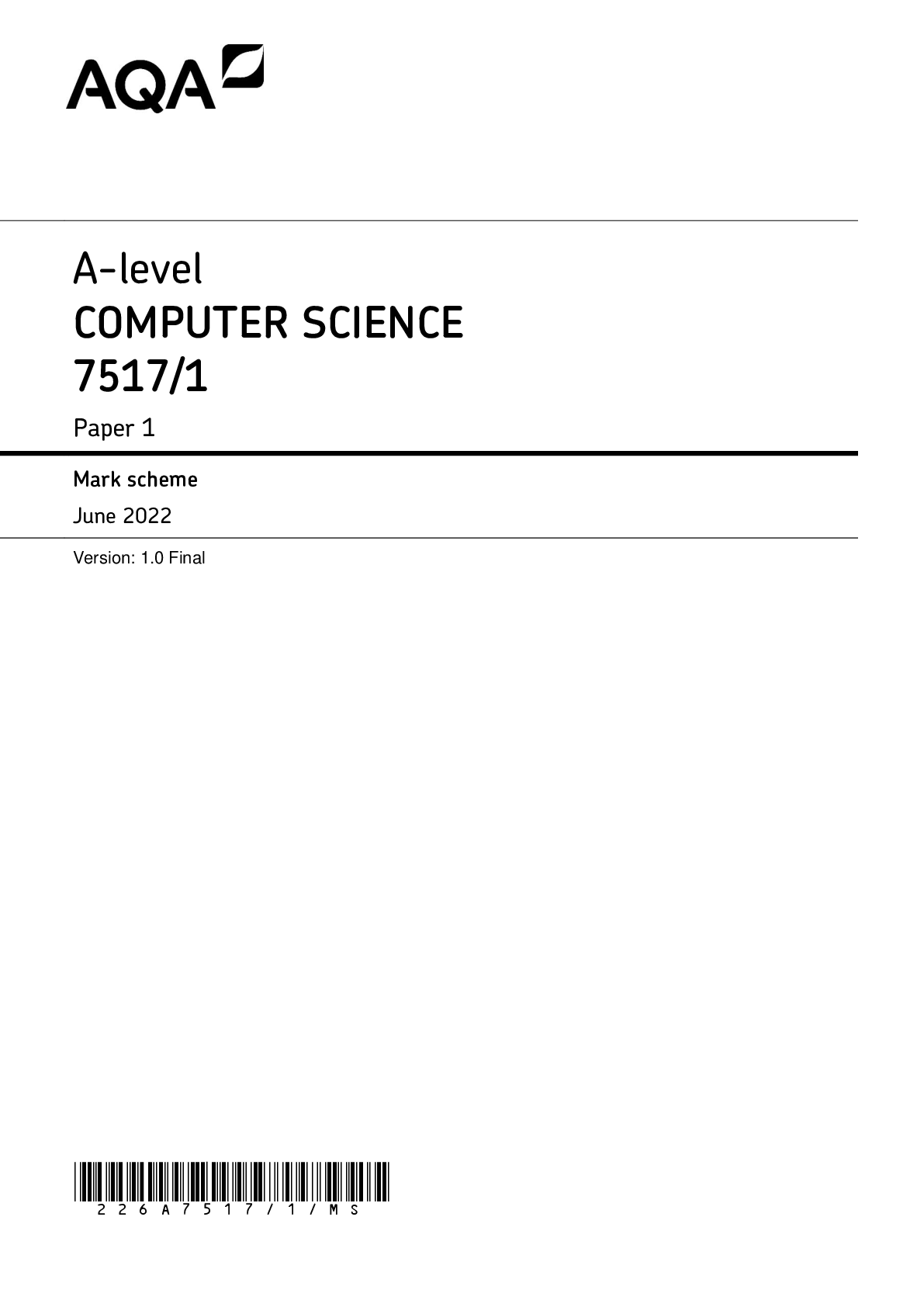
Reviews( 0 )
Document information
Connected school, study & course
About the document
Uploaded On
Apr 01, 2023
Number of pages
52
Written in
Additional information
This document has been written for:
Uploaded
Apr 01, 2023
Downloads
0
Views
75


